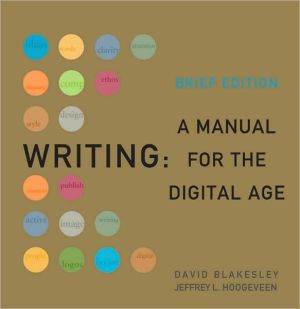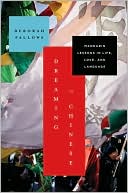Writing: A Manual for the DigitalAge, 2009 MLA Update Brief Edition
One of the best ways to excel in your writing course is by using WRITING: A MANUAL FOR THE DIGITAL AGE, BRIEF. Whatever your writing assignment, WRITING: A MANUAL FOR THE DIGITAL AGE, BRIEF gives you the answers and help you need to succeed. And best of all, this information is right at your fingertips thanks to the handbook's easy-to-access format, which you'll find as visually interesting and easy to navigate as your favorite website! Whether you need grammar help, or information on...
Search in google:
One of the best ways to excel in your writing course is by using WRITING: A MANUAL FOR THE DIGITAL AGE, BRIEF. Whatever your writing assignment, WRITING: A MANUAL FOR THE DIGITAL AGE, BRIEF gives you the answers and help you need to succeed. And best of all, this information is right at your fingertips thanks to the handbook's easy-to-access format, which you'll find as visually interesting and easy to navigate as your favorite website! Whether you need grammar help, or information on drafting and shaping content, developing paragraphs, researching online, citing sources, using visuals, writing on the Web, and so much more, this is the handbook that will get you there!
Part I: MANAGING YOUR WRITING. 1. Writing and Rhetoric in Context. 2. Inventing and Developing Content. 3. Revising, Editing, and Proofreading. Part II: READING AND WRITING CRITICALLY. 4. Reading Critically. 5. Reading Literature Critically. 6. Reading Images Critically. 7. Writing Arguments. 8. Writing for Business and the Workplace. Part III: CONDUCTING RESEARCH. 9. Conceptualizing the Research Project. 10. Online Research. 11. Library and Field Research. 12. Using Source Ethically. Part IV: MLA STYLE. 13. MLA Documentation. Part V: APA, CMS, CSE, AND CGOS STYLES. 14. APA Documentation. 15. CMS Documentation. 16. CSE Documentation. 17. CGOS Documentation. Part VI: DESIGNING AND PRESENTING INFORMATION. 18. Using Visuals to Inform and Persuade. 19. Desktop Publishing and Graphic Design for Writers. 20. Designing Interactive Oral Presentations. Part VII: WRITING IN DIGITAL SPACES. 21. Networking with Others on the Web. 22. Writing and Rhetoric on the Web. 23. Designing Websites and Multimedia Projects. Part VIII: MAKING CHOICES ABOUT STYLE. 24. Sentences in Context. 25. Parallelism. 26. Coordination and Subordination. 27. Conciseness, Variety, and Emphasis. 28. Effective Word Use. 29. Language and Diverse Audiences. Part IX: UNDERSTANDING AND REVISING SENTENCES. 30. Parts of Speech and Sentence Structure. 31. Fragments. 32. Run-Ons and Comma Splices. 33. Pronouns. 34. Verbs. 35. Subject-Verb Agreement. 36. Adjectives, Adverbs, and Modifying Phrases. Part X: PUNCTUATING WITH PURPOSE. 37. End Punctuation. 38. Commas. 39. Semicolons. 40. Colons. 41. Apostrophes. 42. Quotation Marks. 43. Other Punctuation Marks. Part XI: UNDERSTANDINGMECHANICS. 44. Capitalization and Italics. 45. Abbreviations and Numbers. 46. Spelling and Hyphens. Part XII: GRAMMAR FOR MULTILINGUAL WRITERS. 47. ESL Writing for Academic Purposes. 48. Nouns and Articles. 49. Verbs and Verbals. 50. English Sentence Structure. Glossary. Index.








